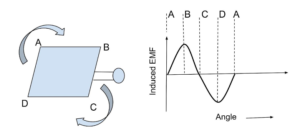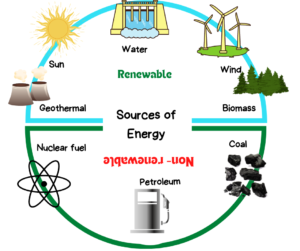Introduction
An engine used to convert mechanical energy into electrical energy is an AC generator. Steam turbines, gas turbines, water turbines, and other similar devices all generate this energy. It creates a sinusoidal waveform of alternating current. Alternators are another name for AC generators. The electromagnetic induction law of Faraday is the foundation of an AC generator. According to this rule, anytime a conductor is exposed to a variety of magnetic fields, an electromotive force (EMF) is generated across it. This EMF is referred to as an induced EMF. Electromagnetic induction is the term for this phenomenon. Induced electromagnetic induction is the process by which a coil develops a potential difference as a result of changes in the magnetic flux flowing through it. Several types of AC generators, including polyphase generators, rotating field generators and spinning armature generators.
For more details watch the video of the Science Course for classes 6th, 7th, and 8th.
What is an AC Generator?
An AC generator is an engine that converts mechanical energy into electrical energy in the form of an alternating driving force. To provide a consistent magnetic field, an AC generator uses two magnet poles.
AC Generator Parts and Function
An electromagnet with two poles, the North Pole and the South Pole, is a component of an AC generator. Below is a discussion of certain AC generator components, including the rotor, slip rings, and armature loop.
a. Field
The output voltage of an AC generator is obtained from the source using conductor loops. The field’s main function is to provide a magnetic field that will stimulate the gadget.
b. Armature
The armature coil is a coil that is part of the generator and produces output voltage. An armature coil’s job is to move electricity through the generator.
c. Prime Mover
The primary mover of an AC generator is either an engine or a turbine. It serves as the appliance’s power supply.
d. Rotor
A rotor is a revolving component with magnetic field spirals. It generates the necessary output voltage.
e. Stator
A stationary part holding the armature spirals is called a stator. A stator includes three different parts. They are stator frame, stator core, and armature spirals.
- Stator frame: A frame that grips the stator core and armature spirals.
- Stator core: There are slots in the inner part of the core that hold the armature spirals. A steel or iron is coated on the walls of the stator core to decrease the eddy current losses.
- Armature winding: They are bounded on the stator core.
f. Slip Rings
There are two small rectangular blocks fixed with slip rings called carbon brushes. They are attached to the galvanometer.
Principle of Electric Generator
The basis of AC generators is Faraday’s law of electromagnetic induction. A current-carrying coil placed in a consistent field of force produces the driving force that is referred to as the law.
Construction and Working of an AC Generator
An AC generator consists of a rectangular coil with two magnet poles attached to it on either side. Two rings are used to fasten the coil’s (or loop’s) perimeter. The rings are joined together with brushes. When a conductor travels in a magnetic field, an electric
The generator induces a current in it.

Between the magnet’s poles, a rotating rectangular coil, also known as an armature, is used. The magnetic field’s vertical axis is the centre of rotation. The flux in contact with the armature changes as it rotates constantly. The alteration in flux results in the generation of an emf. As a result, the galvanometer, slip rings, and carbon brushes produce an electric current. While direct current only travels in one direction, alternating current sometimes flips direction.

The production of the AC generator shown in the above graph is described as
- Induced EMF is zero when the coil is at point A because it moves equidistantly from the magnetic field’s curve at that point.
- A gradient of 90o is created between the coil‘s motion and the magnetic field as it moves from point A to point B, and induced EMF is at its highest level during this time.
- Moving the coil from A to B results in the same motion being equally far from the magnetic field and no generated EMF.
- The induced EMF is once more at its highest when the coil is moved from C to D since its motion is antiparallel to the magnetic field and its angle is 270o.
- The coil completes one cycle and moves equally far from the magnetic field when it moves from D to A. Induced EMF is therefore zero.
Advantages of AC Generator Over DC Generator
Category |
AC Generator |
DC Generator |
| Output Voltage | Higher Output Voltage. | It cannot generate a higher output voltage as it damages the functioning of the commutator. |
| Construction | Simpler construction | Construction is complicated due to a commutator. |
| Functioning | Works on the principle of electromagnetic induction. | DC generator functioning is more complex than an AC generator. |
| Maintenance | It demands less maintenance. | It demands more maintenance than an AC generator. |
| Cost | Cheaper | Costs higher than AC generator |
| Efficiency | Transmission efficiency is higher as AC reduces transmission losses. | Transmission efficiency is lower. |
You can also read “What is AC Voltage Capacitor?” for explanation of AC voltage.
Summary
A generator is an engine that changes one type of energy into another. Large currents are produced by electric generators for usage in industrial and domestic applications. There are two different kinds of electric generators: DC generators, which convert mechanical energy into direct current. A generator of alternating current that converts mechanical energy. On the Faraday law of EMI theory, an AC generator was placed. In an AC generator, the flux in contact with the armature varies as it rotates continuously. The shift in flux causes an emf to be generated. As a result, the galvanometer, slip rings, and carbon brushes produce an electric current. As an AC generator produces higher output voltage, it is easier to build, requires less maintenance, is more efficient, and is less expensive than a DC generator. Large currents are produced by electric generators for usage in industrial and domestic applications.
Frequently Asked Questions
1. Can we Generate EMF without Rotating the Coil in an AC Generator? Explain.
Ans: Yes, emf may be produced without the coil revolving. If the armature is made to move at a velocity perpendicular to the magnetic field, Emf can also be produced.
2. What is the reason for Heat Loss in the Generator?
Ans: Reasons for the heat loss in the generator can be, (a) generation of the by-products like carbon dioxide, and molecular friction, which can reduce the efficiency. The heat loss hinders the efficiency of the generator. So, the efficiency is never 100%.
3. What is the Driving Force?
Ans: Induced emf is also termed as the driving force and can be expressed as,
ε = N B Aωsinωt
where N is the number of turns in the coil, B is a magnetic field, A is an area, ω is the angular velocity
So, in an AC generator, the induced emf is proportional to the applied magnetic field.
4. Give examples of DC Sources.
Ans: The electrical appliances like radios, televisions, and solar panels. DC only travels in one direction and lacks any polarity.
